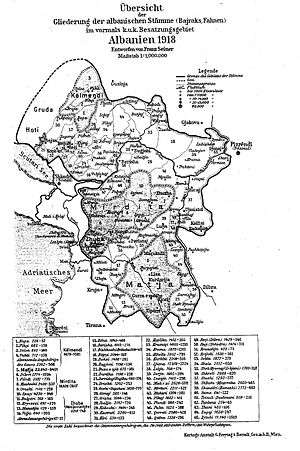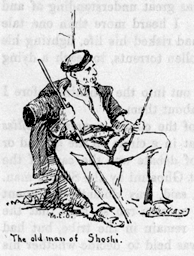Shoshi (region)
Coordinates: 42°12′N 19°47′E / 42.200°N 19.783°E
| Shoshi | |
|---|---|
 Albanians bayraks as of 1918, Shoshi covers section 57. | |
| Ethnicity | Albanian |
| Current region | Northern Albania |
| Connected families | Shala tribe, Mirdita tribe |
Shoshi is a region of northern Albania in the Shala valley whose territory is synonymous with the historic Albanian tribe of the same name.[1] The Shoshi name was first recorded in Italian in 1671 as "Sosi".[2]
Ethnography

The legendary ancestral father of the Shoshi tribe was called "Mark Diti". Mark Ditis brother, "Zog Diti", was the ancestral father of the Shala tribe, and his other brother, "Mir Diti", was considered to be the ancestral father of the Mirdita tribe. [3] Shoshi and Shala is said to have settled the land in a northwards migration from Mirdita. As one of the main Dukagjini tribes, they may have an original tie with the Dukagjini family.[4] Much of their local legendry is, at any rate, connected to Lekë Dukagjini. The area of Kodra e Shëngjergjit, which was the capital of the Dukagjin is situated in the Shoshi territory. [5]
During the late Ottoman period, the tribe of Shoshi was exclusively Catholic and it was a famous Albanian tribe.[6] Shoshi had a distinction in the region of possessing a legendary rock associated with Lekë Dukagjini.[6] According to local tradition, it was to Shoshi that Lekë Dukagjini, came fleeing from Rashia. A rock that stands on a hill side of the valley, marks the spot where he stayed.[7]
After the Young Turk Revolution (1908) and subsequent restoration of the Ottoman constitution, the Shoshi tribe made a besa (pledge) to support the document and to stop blood feuding with other tribes until November 6.[8] During the Albanian revolt of 1911 revolutionaries in negotiations with the Ottomans received an amnesty for the tribesmen with promises by the government to build one to two primary schools in the nahiye of Shoshi and pay the wages of teachers allocated to them.[9]
Religion
The patron Saint of the Shoshi is Saint Cyriacus (Shën Qurk), whose feast day is commemorated on 12 or 15 July.[10][11]
The religion of the tribe is entirely Catholic, in the first reliable census taken in Albania in 1918, the population of the Shoshi were 1,293 inhabitants.[12]
See also
References
- ↑ Historical Dictionary of Albania. Robert Elsie. p. 416.
- ↑ The Tribes of Albania; History, Culture and Society. Robert Elsie. p. 129.
- ↑ The Tribes of Albania: History, Society and Culture. Robert Elsie. p. 121.
- ↑ The Tribes of Albania:History, Society and Culture. Robert Elsie. p. 130.
- ↑ The Tribes of Albania:History, Society and Culture. Robert Elsie. p. 131.
- 1 2 Gawrych 2006, pp. 31-32.
- ↑ The Tribes of Albania; History, Society and Culture. Robert Elsie. p. 132.
- ↑ Gawrych 2006, p. 159.
- ↑ Gawrych, George (2006). The Crescent and the Eagle: Ottoman rule, Islam and the Albanians, 1874–1913. London: IB Tauris. pp. 186-187. ISBN 9781845112875.
- ↑ The Tribes of Albania; History, Culture and Society. Robert Elsie. p. 129.
- ↑ A Dictionary of Albanian Religion, Mythology and Folk Culture. Robert Elsie. p. 63.
- ↑ The Tribes of Albania; History, Culture and Society. Robert Elsie. p. 130.